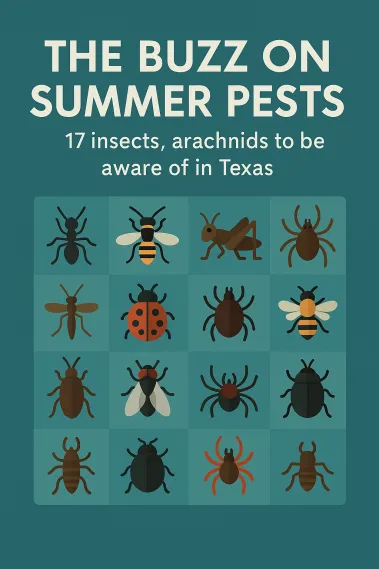The buzz on summer pests: 17 insects, arachnids to be aware of in Texas
Discover 17 common summer pests in Texas, including insects and arachnids. Learn how to identify, prevent, and control them effectively.

Insects to Watch Out For
1. Mosquitoes
Mosquitoes are active from March to November and adore Texas's warm and humid climate. They are recognized to transmit illnesses like West Nile virus and Zika virus. Prevent bites by eliminating standing water, using repellents, and installing window screens.
Hawx Pest Control
2. Fire Ants
Fire ants are known for their painful stings and aggressive behavior. Fire ants are most active from April to July and again from late September through October. Fire ants build dome-shaped mounds in open areas and will invade homes, especially looking for electrical equipment.
Houston Chronicle
3. Red Velvet Ant (Cow Killer)
Despite the name, this is a flightless wasp with a painful sting. Recognized by its bright red and black coloring, it's typically found in sandy areas during the summer. While not aggressive, this is one to steer clear of due to its potent sting.
4. Giant Mesquite Bug
These large, colorful insects feed on mesquite trees and are most frequently found in southern Texas. Nymphs possess bright red and white markings, while adults are dark brown. They are harmless to humans but may be garden pests.
Wikipedia
5. Crane Flies
Often mistaken for giant pink mosquitoes, crane flies are harmless and do not bite. Drawn to night lights, they are a common summer guest.
6. Cockroaches
Texas houses are typical haunts of cockroaches, especially during summer, and species like the American and German can spread disease. Cockroaches like warm, moist places. Keep your house tidy, and seal up openings to keep them out.
Hawx Pest Control
7. Termites
Subterranean and Formosan termites are prevalent in Texas and can cause severe structural damage. They thrive in warm, damp conditions. Inspection and moisture control are key preventive measures.
Hawx Pest Control
8. Wasps and Hornets
Pests like paper wasps and yellow jackets are more active in summer. They can become aggressive when defending their nests. Remove food sources and keep garbage cans sealed to deter them.
Hawx Pest Control
Coles Pest and Termite Control
9. Ants
In addition to fire ants, Texas has a number of other ants that will come into houses searching for food. Seal entry points and keep kitchens clean to prevent infestations.
10. Fleas
Fleas are more prevalent in the summer and can cause injury to pets and people. Treat pets frequently and keep yards tidy to control flea populations.
11. Chiggers
These tiny mites inhabit grassy, wooded fields, and their bites are irritating. They are most active in late spring and summer. Use protective clothing and repellents when traveling through susceptible areas.
The Spruce
Arachnids and Related Pests
12. Black Widow Spiders
Identified by their shiny black bodies and red hourglass-shaped markings, black widows are venomous and prefer being in dark, quiet spots. Be cautious when reaching into storage spaces.
13. Brown Recluse Spiders
They bear a violin-shaped mark on their back and are loners by nature. Their bites may result in severe medical issues. Keep storage areas clean and well-organized to deter them.
14. Scorpions
The most poisonous scorpion in Texas is the bark scorpion. They are nocturnal and prefer hiding in cool, moist areas. Caulk cracks and remove debris to deter indoor entry.
Hawx Pest Control
15. Ticks
Texas has several species of ticks, including the Lone Star tick and blacklegged deer tick, that transmit diseases like Lyme disease and Rocky Mountain spotted fever. Use tick repellent and perform regular checks after being outdoors.
Laredo Morning Times
16. Spider Mites
Infest plants and cause yellowing and webbing on leaves. These small arachnids prefer hot and dry conditions. Inspect the plants regularly and treat them appropriately to manage infestations.
Southern Living
17. Clover Mites
Tiny red arachnids that infest homes in great numbers, particularly in the spring and fall. They are not harmful but can leave stains behind. Seal off cracks and eliminate vegetation around the foundation of the home to discourage entry.
Better Homes & Gardens
Prevention and Control Tips
- Keep Clean: Regularly clean your house, especially kitchens and storage areas, to deter pests.
- Seal Entry Points: Inspect and seal cracks, crevices, and holes around doors, windows, and foundations.
- Control Vegetation: Maintain regularly mowed lawns and remove debris to reduce pest habitats.
- Use Repellents: Apply insect repellents when going outside, especially in wooded or grassy areas.
- Regular Inspections: Conduct regular inspections for signs of infestations and act swiftly.
The Spruce
By being vigilant and proactive, you can minimize the nuisance of these summer pests and enjoy a more comfortable season in Texas.













